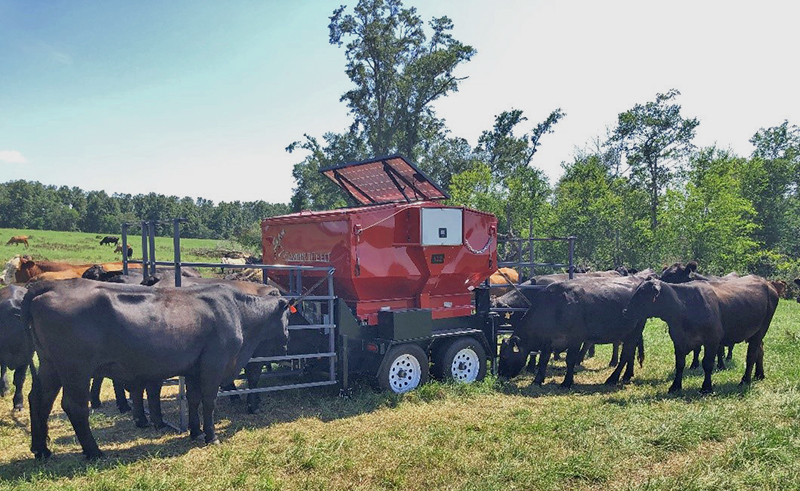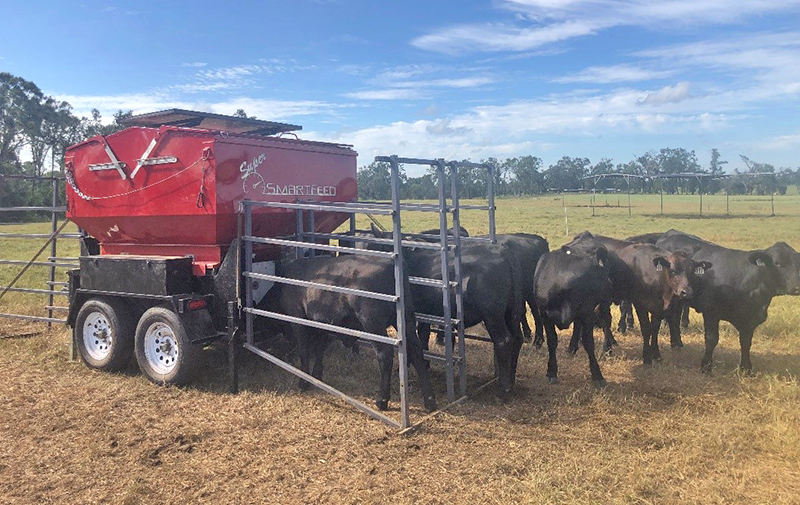Gleise Silva and Nicolas DiLorenzo, UF/IFAS North Florida Research and Education Center
Beef cattle are often provided supplemental nutrients to enhance performance and economic return to the operation, but the labor associated with supplementation can increase total production costs. The amount of supplement to be provided is usually based on the average body weight of a herd, and is often offered using shared feed troughs in the pasture. This practice may be disadvantageous when attempting to do precision supplementation, considering that feed consumption is not consistent throughout the herd. This could be aggravated, if on the same pasture, there are lactating cows, growing heifers, and bulls, all with different nutrient requirements. Therefore, in an effort to overcome the difficulties of providing precise supplementation to cattle grazing or consuming hay, novel technologies utilizing radio-frequency identification (RFID) have been developed. One example of these technologies is the Super SmartFeed™ developed by C-Lock Inc., a company in Rapid City, SD.

Super SmartFeed™ was developed as an in-pasture supplement feeder designed to reduce labor costs associated with feeding, and to deliver precise supplement to each animal individually, even when housed on the same pasture. Researchers at the UF/IFAS NFREC in Marianna purchased a Super SmartFeed unit to conduct studies where different supplementation strategies in beef cattle will be investigated. Credit: Nicolas DiLorenzo, UF/IFAS
Super SmartFeed™
The Super SmartFeed™ was developed as an in-pasture supplement feeder designed mainly to reduce labor costs associated with feeding, and to deliver the supplement to each animal individually, even when housed on the same pasture. This equipment is a portable, self-contained system designed to measure and control supplemental daily intake from individual animals (Figure 1 above). The system contains four feed troughs separated by gates, which allow one animal at a time into each feed pen. There is a large bin located on the top of the machine that can hold up to 5,000 lbs of feed (byproduct pelleted feed supplement). This bin can be subdivided into four compartments, allowing the producer or researcher to have in the same feeder four different supplements. In a practical scenario, this means that a cow-calf producer could use the machine to supplement the cows with a protein feedstuff, while at the same time providing an exclusive creep-feed supplement to the calves. This is possible because the feeder has an online interface that alllows the user to add the individual electronic identification of each animal to be supplemented, and also select the exact amount to be dispensed by the feeder from each of the 4 bins. For example, a cow might receive 2 lbs of supplement A, which is dispensed in bins 1 and 2. When this cow approaches bins 1 or 2, the feed will be dispensed as long as the cow remains in the bunk, and it will stop dispensing feed once the 2 lbs. are delivered. However, if this cow approaches bins 3 and 4 (assuming these bins are filled with a pre-weaning supplement for the calves) the feed would not be dispensed. With a head sensor located in front of each bin, the Super SmartFeed can read the electronic tags and control which and how much of each feed should be provided to that individual animal.
The feeder is mounted on a trailer for transportation throughout the farm or even off-farm. In addition, the feeder contains a solar panel that charges two batteries allowing the feeder to operate autonomously for long periods of time. For supplementation on pasture, it is estimated that one single unit can serve about 100 animals being supplemented with a meal, pellets, corn, or chopped fibrous feedstuffs. All data, such as the amount of feed left in the bin, solar panel voltage, and individual feed intake, are reported in real-time through the online interface; therefore, the producer can monitor the herd from their computer or smart phone.
Using this technology for research
Recently researchers at the University of Florida’s North Florida Research and Education Center (NFREC) in Marianna purchased a Super SmartFeed unit to conduct studies where different supplementation strategies for beef cattle will be investigated. A preliminary study at the NFREC using the Super SmartFeed was just concluded. Researchers evaluated 48 recently weaned beef heifers over a 28-day period consuming a byproduct pellet to test this new technology. Each heifer was allowed to consume 2.5% of their body weight (BW) of the pellet while grazing bahiagrass pasture in September and October. On the first day of the trial, 25% of the heifers did not approach the Super SmartFeed unit. However, after 28 days of the trial, only 8% of the heifers inconsistently visited the unit. During the last week of the trial, 85% of the heifers were consuming at least 1.5% of their BW. Over the 28 days of observation, heifers consumed 1.8% of their BW using the Super SmartFeed. Considering this preliminary data, even though heifers did not reach the proposed intake, this data showed that the Super SmartFeed can be used as a tool to supplement grazing beef cattle with a supplement rate of up to 1.5% of their BW. The 2.5% of the BW was used on purpose to test the upper limits of the supplementation capacity of this new technology. Typical supplemental amounts are generally below 1.5% of cattle BW, which shows the potential of this technology under the conditions tested.

Researchers at the UF/IFAS NFREC evaluated 48 weaned beef heifers over a 28 day period consuming a byproduct pellet to test this new technology. Each heifer was allowed to consume 2.5% of their body weight (BW) of the pellet while grazing the remains of a bahiagrass pasture in the fall. Credit: Nicolas DiLorenzo, UF/IFAS
Take home message
Supplementation of grazing beef cattle is a management tool widely used to improve animal performance. New technologies are being developed to reduce labor costs associated and provide individual control of feed intake. Although these are preliminary results, the C-Lock Super SmartFeed unit seems to be a viable option to individually supplement cattle on the same pasture. For adoption in most practical situations, the labor and feed cost savings will need to be sufficient to offset the purchase and maintenance cost of this technology. More research will be conducted at NFREC to understand how to make the best use of this novel technology, and to provide practical recommendations.
For more information on the Super SmartFeed™ system, watch the following video made by the manufacturer:
- Stretching Hay Reserves is Critical during this “Flash Drought” - September 26, 2025
- 2025 Florida Bull Test Sale Sets Average Price Record - March 7, 2025
- Intake Limiters:Old Technology for Modern Beef Cattle Supplementation - September 20, 2024
